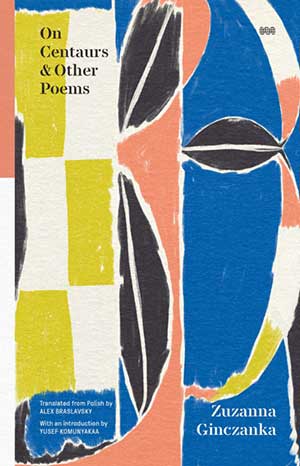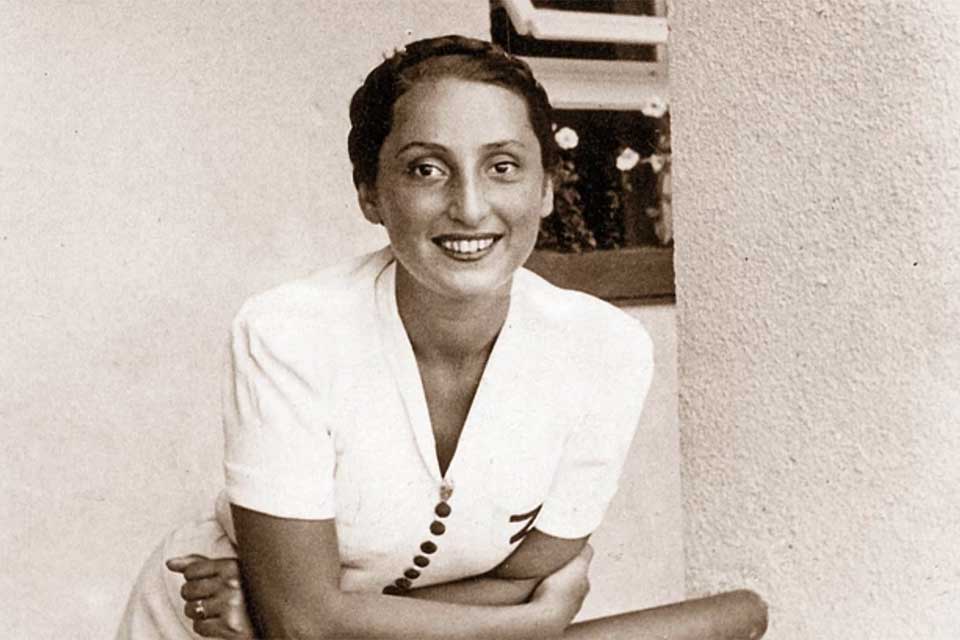History displaced Zuzanna Ginczanka (1917–1944) from birth. Born in Kiev a few days after the outbreak of the October 1917 Bolshevik revolution, she was left by her parents to be raised by her grandmother. She grew up in the Volhynian town of Równe (today Rivne) surrounded by Poles, Russians, Ukrainians, Armenians, Tatars, and Jews. With Russian her mother tongue, at age fourteen she had chosen Polish as her poetic language, taken the pen name Ginczanka, initiated a correspondence with Julian Tuwim, and published her first poem, “Holiday Feast,” in her school newspaper. Two years later, in August 1933, “The Fullness of August” was published in the Sunday supplement of the daily national Polish newspaper Ilustrowany Kuryer Codzienny. At the Tadeusz Kościuszko Lyceum in Równe, she received a solid education in the classics, which surfaced in her poems as watermarks of Chinese fairy tales, old German mythology, and Mediterranean and Jewish cultures.
In 1934, under the tutelage of Julian Tuwim, her poem “Grammar” won a prize in the annual competition of young poets and was published in Wiadomości Literackie, Warsaw’s prestigious literary weekly. Language had become her home and her anchor. Barely seventeen, she was already articulating the essence of her poetic philosophy, namely that nouns are “the indispensable essence, / the concreteness of the essence of the thing, / . . . somethings that lasts still and is, a word concentrated in the body” (ix). “Conjugation,” written the same year, confessed that “a rhizome-sprouting word / has invaded me, grown into me like a homeland, / my speech is for me a land / that is fertile, sandy and good – / Do I necessarily have to slice it / into a square – like a banner – a program?” (91). Words became flesh uniting body and abstraction, life and poetry.
 Ginczanka’s adult life was but a whiplash of highs and lows. A stateless person by virtue of her Nansen passport, an expatriate from the idyllic bucolic landscapes of her childhood, she moved to Warsaw in 1935. This eighteen-year-old Jewish woman who had the beauty and poise of a Byzantine icon landed in a predominantly Catholic and patriarchal country. Nicknamed “Tuwim in a skirt,” she saw her studies at the University of Warsaw disturbed by anti-Semitic attacks. Undeterred, she published her first and only book, a slim collection of seventeen poems entitled On Centaurs, in 1936. Its eponymous poem purports to “preach passion and wisdom / tightly conjoined at the waist / like a centaur” and to unite in art what was then strictly separated as male and female (153). This feminist declaration was a rejection of Western dualism with its linear, square, exclusivist world of nation-states. In spite or perhaps because of her pronouncements, she sat at the table of Witold Gombrowicz at the Mała Ziemianska café and counted Czesław Miłosz among her admirers.
Ginczanka’s adult life was but a whiplash of highs and lows. A stateless person by virtue of her Nansen passport, an expatriate from the idyllic bucolic landscapes of her childhood, she moved to Warsaw in 1935. This eighteen-year-old Jewish woman who had the beauty and poise of a Byzantine icon landed in a predominantly Catholic and patriarchal country. Nicknamed “Tuwim in a skirt,” she saw her studies at the University of Warsaw disturbed by anti-Semitic attacks. Undeterred, she published her first and only book, a slim collection of seventeen poems entitled On Centaurs, in 1936. Its eponymous poem purports to “preach passion and wisdom / tightly conjoined at the waist / like a centaur” and to unite in art what was then strictly separated as male and female (153). This feminist declaration was a rejection of Western dualism with its linear, square, exclusivist world of nation-states. In spite or perhaps because of her pronouncements, she sat at the table of Witold Gombrowicz at the Mała Ziemianska café and counted Czesław Miłosz among her admirers.
Ginczanka embraced Skamandrism and wrote poems and two radio dramas. She made her opinion known through pastiches and satires, especially the prescient and well-known poem “May 1939”; in it, she challenged both an over-optimistic eponymous poem by Antoni Słonimski and Robert Frost’s poem “The Road Not Taken,” affirming that both hope and despair, one of which is the road less traveled, will equally end in tragedy. She also denounced social injustice and the plight of the poor in several poems. In September 1939 the outbreak of World War II interrupted her literary career and forced her to hide in plain sight in Lviv, then under Soviet and German occupation. Denounced by her housekeeper, she settled in Kraków, her life extinguished at age twenty-seven by a German bullet in the courtyard of Montelupich prison in the spring of 1944. There is now a Stolperstein with her name on the sidewalk of Plac Teatralna 1 in Rivne.
Will there ever be a definitive edition of Ginczanka’s work? Her poetic oeuvre, according to her biographer Izolda Kiec, consists of 177 poems. Of these, 106 poems were written between 1931 and 1936 (only 11 were published); 17 were published in On Centaurs in 1936; 51 were written between 1936 and 1939 (13 were manuscript or published in Wiadomości Literackie, and 37 were published in the satirical Szpilki); only 3 of her wartime poems seem to have survived. Her signature poem “Non omnis moriar,” which named the woman who betrayed her in Lviv, survived thanks to a copied version that was submitted as evidence in the housekeeper’s 1945 trial. Other unpublished manuscripts may have been lost. She had only fifteen years to write: five teenage years, three “normal” years, and five “survival” years.
 The rebirth of Ginczanka’s poetry is largely due to chance. For an entire century, her memory surfaced episodically. In 1953 her friend from Równe, Jan Spiewak, published a first volume, Wiersze wybrane (Selected poems); in 1991 Kiec started writing about her, and Agata Araszkiewicz followed a few years later. The year 2014, the seventieth anniversary of Ginczanka’s death, marked an earnest rediscovery of her poetry. Alessandro Amenta’s essay and translation came out in 2016 (Le parole e il silenzio. La poesia di Zuzanna Ginczanka e Krystyna Krahelska). Marek Kazmierski published the first volume of English translations, Invoking Zuzanna Ginczanka: Translation in a Time of Love and War, in time for the hundredth anniversary of her birth in 2017. Kiec issued a comprehensive edition, Wiersze zebrane (Collected poems), in 2019. There followed a slew of journal and book translations in many languages. In the West, Bernhard Hofstötter and Hanna Kubiak signed a German translation, Von Zentauren – und weitere ausgewählte Gedichte, in 2021. The ninetieth anniversary of Ginczanka’s literary debut in 2023 will be celebrated with three volumes, two in English and one in French. The two English volumes are On Centaurs and Other Poems (World Poetry Books), which gathers 75 poems in Alex Braslavsky’s translation; and a selection of 33 poems excellently translated by Alissa Valles, Firebird (New York Review Books). The French volume will be an artist’s book featuring 116 poems translated, introduced, and commented by Isabelle Macor (Les Centaures et autres poèmes, Ed. De la barque, December 2023).
The rebirth of Ginczanka’s poetry is largely due to chance. For an entire century, her memory surfaced episodically. In 1953 her friend from Równe, Jan Spiewak, published a first volume, Wiersze wybrane (Selected poems); in 1991 Kiec started writing about her, and Agata Araszkiewicz followed a few years later. The year 2014, the seventieth anniversary of Ginczanka’s death, marked an earnest rediscovery of her poetry. Alessandro Amenta’s essay and translation came out in 2016 (Le parole e il silenzio. La poesia di Zuzanna Ginczanka e Krystyna Krahelska). Marek Kazmierski published the first volume of English translations, Invoking Zuzanna Ginczanka: Translation in a Time of Love and War, in time for the hundredth anniversary of her birth in 2017. Kiec issued a comprehensive edition, Wiersze zebrane (Collected poems), in 2019. There followed a slew of journal and book translations in many languages. In the West, Bernhard Hofstötter and Hanna Kubiak signed a German translation, Von Zentauren – und weitere ausgewählte Gedichte, in 2021. The ninetieth anniversary of Ginczanka’s literary debut in 2023 will be celebrated with three volumes, two in English and one in French. The two English volumes are On Centaurs and Other Poems (World Poetry Books), which gathers 75 poems in Alex Braslavsky’s translation; and a selection of 33 poems excellently translated by Alissa Valles, Firebird (New York Review Books). The French volume will be an artist’s book featuring 116 poems translated, introduced, and commented by Isabelle Macor (Les Centaures et autres poèmes, Ed. De la barque, December 2023).
Ginczanka’s verses are poetry in motion, poised to take flight.
On Centaurs and Other Poems opens with a superbly penned foreword by Yusef Komunyakaa and a thorough biography by Braslavsky. Missing from these essays, however, is a genealogy of the poet’s work and the reason behind the translator’s selections. Braslavsky chose 41 of the 106 poems written between 1931 and 1936; the 17 poems of Of Centaurs; and 17 out of the 54 poems written between 1936 and 1944—a balanced choice for this budding scholar, poet, and translator who is producing here her first volume of translation. Ginczanka wrote in a second language, favored strong images with a tight-woven rhythm, disregarded syntax, joined words in esoteric evocations, carefully staged her poems, and added the counterpoint of a sober or prophetic ending. Her verses are dense yet fluid; they are poetry in motion, poised to take flight. A poetic disposition is certainly an advantage when translating poetry. Overall, Braslavsky’s energetic and modern translation captures Ginczanka’s images well; yet disconcertingly prosaic phrases indicate some unease with the poet’s wordplays. The last verse of “New Year’s: A Handmade Greeting Card,” for example, remains as opaque in the volume’s translation as in the earlier version Braslavsky penned in Plume #138 (February 2023).
Much has been written about Ginczanka through the feminist tropes of body, identity, and sexuality. Ginczanka’s womanhood poems transcend all three, which is quite extraordinary since they were written when she was between the ages of fourteen and nineteen. She inscribes sexuality in the context of a woman’s reproductive life cycle, from the first adolescent stirrings to womanhood to motherhood. She does not shy away from evoking the physical act of love, the revolt of fifteen-year-old girls against bourgeois conventions, or the poet’s empathy for a teenage prostitute, although sexuality is laced with metaphor (“Woman”). Most importantly, womanhood espouses the rhythms of the earth and is a spiritual state of mind, emotion, and body (“In Heat”). Womanhood means communing with harvests and animal births and affirming one’s soul. Nature and body are symbiotically tied through the life-giving activities of love and food.
Her first poem, “Holiday Feast,” written at age thirteen, describes the earth as a gray clay plate painted grass-green, with flowers a “fragrant salad” on which the sun pours “golden honey.” The night sky is showered with stars that fill “the universe’s sugar bowl.” The poet drinks foamy clouds while biting “with the teeth of my feelings into stolen apples or reddened days / And in the basket of my heart I hide the peels of memories already eaten” (25). This arresting poem, a response to Stalin’s Holodomor, affirms life, love, and food at the physical and spiritual levels. Ginczanka understood nature as a cosmic presence, not just the Arcadia described by Hayim Nahman Bialik. In an extraordinarily prescient poem, “Ascension of the Earth,” eroticism rejoins environmental prophecy, as the earth first submits to the violence committed against her before raging “free: / of river, forest and field / and in the fires of its own blood – / fall down in worship to God” (63).
Ginczanka’s poetry remains unblemished by time, forever young in its youthful clarity and sensitivity to the world.
Ginczanka’s poetry remains unblemished by time, forever young in its youthful clarity and sensitivity to the world. It did resonate with the counterpoints of her times just as it resonates with ours. She could have been Anne Frank’s older sister, mentor, and favorite poet. Both women bequeathed to us their fierce affirmation of life.
University of Tennessee at Martin
